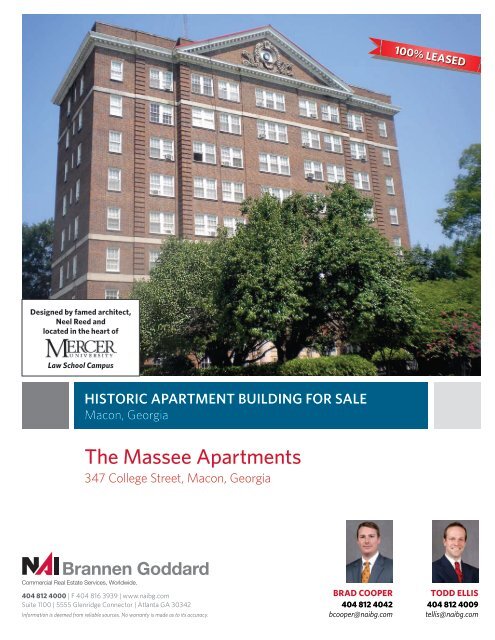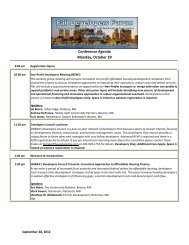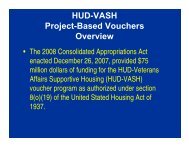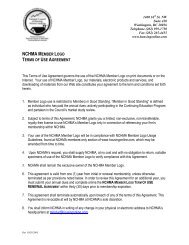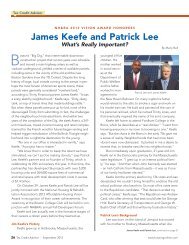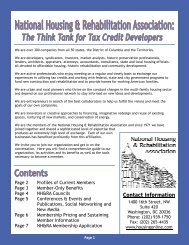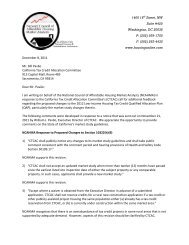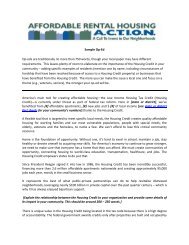The Massee Apartments - National Housing & Rehabilitation ...
The Massee Apartments - National Housing & Rehabilitation ...
The Massee Apartments - National Housing & Rehabilitation ...
Create successful ePaper yourself
Turn your PDF publications into a flip-book with our unique Google optimized e-Paper software.
100% LEASEDDesigned by famed architect,Neel Reed andlocated in the heart ofLaw School CampusHISTORIC APARTMENT BUILDING FOR SALEMacon, Georgia<strong>The</strong> <strong>Massee</strong> <strong>Apartments</strong>347 College Street, Macon, GeorgiaBrannen GoddardCommercial Real Estate Services, Worldwide.404 812 4000 | F 404 816 3939 | www.naibg.comSuite 1100 | 5555 Glenridge Connector | Atlanta GA 30342Information is deemed from reliable sources. No warranty is made as to its accuracy.BRAD COOPER404 812 4042bcooper@naibg.comTODD ELLIS404 812 4009tellis@naibg.com
TABLE OF CONTENTSSectionOne |Executive SummaryTwo |Property OverviewThree |Location SummaryFour |Appendix- Property Photos- Neel Reed, Architect- DemographicsBrannen GoddardCommercial Real Estate Services, Worldwide.<strong>The</strong> information contained herein was obtained from sources we believe to be reliable. However, neither Brokernor Owner has verified all of the information and makes no representation, warranty or guarantee of its accuracyor completeness. This Offering Memorandum is provided subject to the possibility of errors, omissions, change ofprice, prior sale or withdrawal from sale without notice.
EXECUTIVE SUMMARYWe are pleased to submit our offering memorandum for <strong>The</strong> <strong>Massee</strong><strong>Apartments</strong> in Historic Downtown Macon, Georgia. We share with you thefollowing information to highlight key points of this great opportunity.<strong>The</strong> <strong>Massee</strong>’s main entranceConveniently located in Macon’s downtown historical district, <strong>The</strong> <strong>Massee</strong>offers a unique way of life for the resident who appreciates character andcharm. This 78-year-old building is a tribute to the skills of Neel Reid, theregion’s foremost architect of the 1920’s who designed the building to bebeautiful as well as functional. Like other Reid designs, <strong>The</strong> <strong>Massee</strong> is anarchitecture landmark – the handsome ornamental work surrounding thedoorway; wide terra cotta rile terrace and wrought iron railings, door grillesand torches complete the stage for its dramatic entrance. <strong>The</strong> building iseight-stories high with 74 units that consist of one and two bedroomapartments and efficiencies and studios. Each apartment has its owncharacter and charm.<strong>The</strong> <strong>Massee</strong> houses a diversified group of residents including senior residents,graduate students and young professionals and is currently 100% leasedwith below market rents. <strong>The</strong> <strong>Massee</strong> is only one block from the prestigiousMercer Law School and less than one mile from Mercer University.Potential Uses & Value-Add Opportunitiesfor <strong>The</strong> <strong>Massee</strong>:• Fully furnished student housing units to serve Mercer University andMercer Law students thus increasing rental rates• 9% tax credit funded acquisition/rehab opportunity-senior• 4% tax credit funded acquisition/rehab opportunity-senior• Rehab using historic tax credits• Reposition rents by upgrading the current electrical to allow for washerand dryer units and upgraded HVAC systems in each unit<strong>The</strong> <strong>Massee</strong>’s lobby• Conversion to a hotel• Acquisition with a condo sale exit strategy in the futureBrannen GoddardCommercial Real Estate Services, Worldwide.
PROPERTY OVERVIEWSite PlanBrannen GoddardCommercial Real Estate Services, Worldwide.
Stewarts LaneMadison StreetPROPERTY OVERVIEWProperty AerialJefferson Terrace2nd AvenueCollege StreetBrannen GoddardCommercial Real Estate Services, Worldwide.
PROPERTY OVERVIEWMacon Historic DistrictSITEBrannen GoddardCommercial Real Estate Services, Worldwide.
PROPERTY OVERVIEWEXECUTIVE SUMMARYLocation MapsSITEMercerLaw SchoolMercerUniversitymicro mapSITEmacro mapBrannen GoddardCommercial Real Estate Services, Worldwide.
PROPERTY OVERVIEWCompetitive PropertiesSITECompetitive<strong>Apartments</strong>:#1#41. Ashley Towers1 BDR – $5952 BDR – $7252 BDR / 2 BTH – $995Studio w/Kitchen –$4952. <strong>The</strong> TerraceStudio w/Kitchen –$4501 BDR – $550-$6752 BDR - $885-$9753. Broadway2 BDR / 2 BTH – $8504. Katherine Court2 BDR / 1 BTH – $775#2#3Brannen GoddardCommercial Real Estate Services, Worldwide.
LOCATION SUMMARYSITE<strong>The</strong> <strong>Massee</strong> is located in the “Heart of Georgia” in Macon, Bibb County, Georgia, which is central Georgia’s largest city aswell as its anchor. This unique, historical property resides in Macon’s Historical District, which contains a significant andvaried collection of residential buildings that range from landmark mansions to small worker homes.This distinctive building is only one block from the prominent Mercer Law School and less than one mile from MercerUniversity.Brannen GoddardCommercial Real Estate Services, Worldwide.
LOCATION SUMMARYMacon, GeorgiaMacon is a city located in central Georgia and is the county seat of BibbCounty. Macon is the biggest city in central Georgia and lies near thegeographic center of Georgia, approximately 85 miles south of Atlanta, hencethe city’s nickname as the “Heart of Georgia.” Its population is the seventhlargestcity in Georgia (just after Sandy Springs, Georgia).Macon has 12 <strong>National</strong> Register Historic Districts and two national HistoricLandmarks as well as a national monument. Macon’s city auditorium has thelargest covered copper dome in the world and the Hay House, built in the1850s, is a historic museum. <strong>The</strong> Bibb County courthouse was constructedin 1924 and remodeled in 1940. <strong>The</strong> courthouse is listed within the <strong>National</strong>Register of Historic Places.Georgia Music Hall of Fame<strong>The</strong> city has several institutions of higher education, as well as numerousmuseums and tourism sites. Macon is home to Wesleyan College, founded in1836 as the Georgia Female College, the first college in the world charteredto grant degrees to women. Mercer University and Georgia College are alsolocated in Macon.Macon is also home to the Georgia Music Hall of Fame and the GeorgiaSports Hall of Fame. <strong>The</strong>se two facilities play an integral role in the ongoingrevitalization of downtown Macon.Georgia’s largest African American museum, Tubman African AmericanMuseum, offers fourteen exhibition galleries, a resource center and a 63”mural depicting African-American art, history and culture. Permanentcollections are accompanied by touring national and international exhibitionsby well-known African American artists.<strong>The</strong> Douglas <strong>The</strong>atre, built in 1921 by black entrepreneur Charles Douglass, isa restored historic theatre that has hosted greats like Ma Rainey, Bessie Smith,Ida Cox and Cab Calloway. <strong>The</strong> Douglass <strong>The</strong>atre now pays tribute to the AfricanAmerican influence on film and theatre.ride at the Georgia State Fair<strong>The</strong> most popular event in the county is the Macon International CherryBlossom Festival held in March. <strong>The</strong> city has more Yoshino cherry trees thananywhere else in the world, and people come to the annual festival to see thetrees. Other festivals include the annual First Night Macon, Tubman MuseumPan African Festival in May and the Georgia State Fair.Brannen GoddardCommercial Real Estate Services, Worldwide.
LOCATION SUMMARYHistoric MaconMacon boasts 12 historic districts containing over 5,500 historic buildings, alllisted on the <strong>National</strong> Register of Historic Places. Macon has more listedhistoric districts than any other city in Georgia.<strong>The</strong> Macon Historic District is the historic commercial, residential and institutionaldevelopment that grew out of Macon’s original town plan and formsthe city’s historic core. <strong>The</strong> district’s development began in 1823 when thetown plan was first laid out and continued into the 1940’s. <strong>The</strong> district issignificant in the areas of architecture, commerce, community planning anddevelopment, politics/government, landscape architecture, education andtransportation.historic home near the propertyview of historic Macon from<strong>The</strong> <strong>Massee</strong> <strong>Apartments</strong><strong>The</strong> historic Terminal Station is an exceptional example of monumentalarchitecture in downtown Macon. <strong>The</strong> former railroad station was designedin the Beaux Arts style and with Beaux Arts planning principles.Historic community institutional buildings are another group of prominentfreestanding buildings located throughout the district. Christ Church,Mulberry Street United Methodist Church and First Presbyterian Churchare all over 175 years old. <strong>The</strong>y are examples of Gothic Revival, RichardsonRomanesque and High Victorian Gothic. <strong>The</strong> majority of Mercer University’sbuildings are variations of the Academic Gothic Revival style and VictorianGothic and Neoclassical Revival.<strong>The</strong> district contains a significant and varied collection of residential buildingsthat range from landmark mansions to small worker homes. <strong>The</strong>re are threedistinct neighborhoods within the district that depict the various styles ofarchitecture: Intown Neighborhood, Huguenin Heights and Tatnall SquareHeights. Part of the Intown neighborhood includes College Hill where Macon’supper class citizens constructed a number of landmark houses. <strong>The</strong>se housesare very large and generally date from the 19th century; many are the work ofprominent Macon architects.Brannen GoddardCommercial Real Estate Services, Worldwide.
LOCATION SUMMARYMercer UniversityMercer University is one of America’s oldest and most distinctive institutionsof higher learning, offering programs that span from undergraduate liberal artsto doctoral-level degrees. <strong>The</strong> school was founded in 1833 by early 19th centuryBaptists, while no longer formally affiliated with the Baptist denomination,the school is still committed to its original values that arise from a Judeo-Christian understanding of the world.With more than 8,000 students enrolled in 11 schools and colleges oncampuses in Macon, Atlanta and Savannah; and at four Regional AcademicCenters around the state, Mercer is consistently ranked among the nation’sleading institutions by such publications as U.S. News & World Report and thePrinceton Review. Our more than 65,000 alumni are making importantcontributions to their professions and communities throughout Georgia, theSoutheast and the world.While offering a breadth of programs found at much larger universities,Mercer maintains an intimate, student-focused culture more characteristicof smaller liberal arts colleges. Mercer’s uniqueness is found in the way theUniversity integrates five defining components of its mission: Liberal Learning,Professional Knowledge, Discovery, Service to Mankind and Community.Mercer campus mapWalter F. George School of LawFounded in 1873, the Walter F. George School of Law of Mercer University isone of the oldest law schools in the United States and the first in the state ofGeorgia to be accredited by the American Bar Association. <strong>The</strong> Law Schoolis named after Walter F. George, a 1901 Mercer Law School graduate whobecame a justice of the Georgia State Supreme Court and later a U.S. Senator.<strong>The</strong> Law School’s current building is on Coleman Hill, a well-known landmarkon the Macon skyline. <strong>The</strong> 90,000-square-foot facility is modeled afterIndependence Hall in Philadelphia, PA, the location where the Declaration ofIndependence was debated, adopted and signed.Mercer Law School has earned a reputation as an excellent provider of legaleducation with an intense focus on student and faculty interaction. It is alsohome of the <strong>National</strong> Criminal Defense College, the Legal Writing Instituteand <strong>The</strong> Journal of Southern Legal History; and is nationally recognized for itsexceptional programs in legal writing, moot court, public service and professionalismand ethics.Brannen GoddardCommercial Real Estate Services, Worldwide.
APPENDIXNeel ReidNeel Reid Architect (1885-1926)For several generations Neel Reid was the best-known residential architectin Atlanta. His houses enjoyed a pedigree, level of prestige, and quality thatmade them the most sought after in the city. Owning a Neel Reid house, withits refinement of style, was thought to be a mark of taste and social acceptability.That Reid’s firm, Hentz and Reid, was one of the most importantAtlanta firms of the 1910s.J. Neel ReidEducation and Early CareerJoseph Neel Reid was born in Jacksonville, Alabama, in 1885. He was broughtup and educated there until 1903, when his family moved to Macon, where heapprenticed with Curran Ellis. He then went to Atlanta, where he worked forthe architect W. F. Denny. From 1905 to 1907 both Reid and his future partnerHal Hentz attended Columbia University in New York. <strong>The</strong> friends thereaftertraveled in Europe, where Reid is said to have studied briefly at the Ecole desBeaux-Arts in Paris. After a brief period in New York City, Reid joined Hentzlate in 1909 in partnership in Atlanta. <strong>The</strong>ir third partner, the establishedarchitect G. L. Norrman, committed suicide soon after the firm of Norrman,Hentz and Reid was formed. In 1909 the firm became Hentz and Reid, theleading Beaux-Arts architects in Atlanta. Rudolph Adler joined the firm in 1911,and becoming a partner in 1913.Institutional and Commercial ArchitectureAmong the firm’s institutional and commercial buildings in Atlanta are theHillyer Trust Company Building (1911); the Butler Street YMCA (1916-20), withthe African American builder Alexander D. Hamilton, of Alexander Hamiltonand Son; Brookwood Station for Southern Railway (1916-17); the Scottish RiteHospital for Crippled Children (1918-19); and three commercial buildings inthe Fairlie Poplar district of Atlanta: the George Muse Clothing Store (1921,converted to lofts), Haas Howell Building (1920), and the Benjamin WatkinsBuilding (1922, razed). Notable apartment buildings include the Della Manta(1917), 696 Peachtree <strong>Apartments</strong> (1922), and Garrison (later Reid House)<strong>Apartments</strong> (1923-24), all in Atlanta, as well as the <strong>Massee</strong> Apartment Building(1924) in Macon.Reid (and his partners in Hentz and Adler) founded the Georgia school of classicistsafter study at Columbia University and abroad. Many sourcesinfluenced Reid’s architecture, and his interior and garden designs. His traveldiary, sketchbooks and scrapbooks, and extensive library reflect this. Hisearly-twentieth-century interest in historic preservation and contextualdesign, in architectural education and professional standards of practiceinspired others long after his tragic early death of a brain tumor in 1926.Brannen GoddardCommercial Real Estate Services, Worldwide.
MARKET OVERVIEWDemographics – 1, 3 & 5 MilesSite Map347 College St, Macon, GA, 31201Ring: 1, 3, 5 Miles Latitude: 32.8422Longitude: -83.63771SOURCE: ESRI.comBrannen GoddardCommercial Real Estate Services, Worldwide.July 14, 2011Made with Esri Business Analyst©2011 Esri www.esri.com/ba 800-447-9778 Try it Now! Page 1 of 1
MARKET OVERVIEWDemographics – 1, 3 & 5 MilesExecutive SummaryLatitude: 32.8422347 College St, Macon, GA, 31201 Longitude: -83.63771Ring: 1, 3, 5 Miles1 mile radius 3 miles radius 5 miles radius2010 PopulationTotal Population 7,624 48,047 93,217Male Population 48.9% 44.1% 44.6%Female Population 51.1% 55.9% 55.4%Median Age 35.7 34.9 35.42010 IncomeMedian HH Income $20,883 $26,831 $33,057Per Capita Income $16,443 $16,987 $18,238Average HH Income $32,973 $39,525 $44,3742010 HouseholdsTotal Households 3,576 19,545 37,079Average Household Size 1.94 2.31 2.392010 <strong>Housing</strong>Owner Occupied <strong>Housing</strong> Units 16.7% 30.1% 37.8%Renter Occupied <strong>Housing</strong> Units 55.8% 46.1% 41.3%Vacant <strong>Housing</strong> Units 27.6% 23.8% 20.9%Population1990 Population 9,266 57,668 104,5282000 Population 7,780 49,922 95,9362010 Population 7,624 48,047 93,2172015 Population 7,523 47,222 91,9091990-2000 Annual Rate -1.73% -1.43% -0.85%2000-2010 Annual Rate -0.2% -0.37% -0.28%2010-2015 Annual Rate -0.27% -0.35% -0.28%In the identified market area, the current year population is 93,217. In 2000, the Census count in the market area was 95,936. <strong>The</strong> rate ofchange since 2000 was -0.28 percent annually. <strong>The</strong> five-year projection for the population in the market area is 91,909, representing a changeof -0.28 percent annually from 2010 to 2015. Currently, the population is 44.6 percent male and 55.4 percent female.Households1990 Households 4,428 22,892 40,4322000 Households 3,661 20,302 38,0962010 Households 3,576 19,545 37,0792015 Households 3,534 19,245 36,6231990-2000 Annual Rate -1.88% -1.19% -0.59%2000-2010 Annual Rate -0.23% -0.37% -0.26%2010-2015 Annual Rate -0.24% -0.31% -0.25%<strong>The</strong> household count in this market area has changed from 38,096 in 2000 to 37,079 in the current year, a change of -0.26 percent annually.<strong>The</strong> five-year projection of households is 36,623, a change of -0.25 percent annually from the current year total. Average household size iscurrently 2.39, compared to 2.42 in the year 2000. <strong>The</strong> number of families in the current year is 22,294 in the market area.<strong>Housing</strong>Currently, 37.8 percent of the 46,871 housing units in the market area are owner occupied; 41.3 percent, renter occupied; and 20.9 percentare vacant. In 2000, there were 43,909 housing units - 43.5 percent owner occupied, 43.3 percent renter occupied and 13.2 percent vacant.<strong>The</strong> rate of change in housing units since 2000 is 0.64 percent. Median home value in the market area is $76,267, compared to a medianhome value of $157,913 for the U.S. In five years, median home value is projected to change by 0.69 percent annually to $78,946. From2000 to the current year, median home value changed by 1.08 percent annually.SOURCE: ESRI.comSource: U.S. Bureau of the Census, 2000 Census of Population and <strong>Housing</strong>. Esri forecasts for 2010 and 2015. Esri converted 1990 Census data into 2000 geography.©2011 Esri 7/14/2011 Page 1 of 2Brannen GoddardCommercial Real Estate Services, Worldwide.
MARKET OVERVIEWDemographics – 1, 3 & 5 MilesExecutive SummaryLatitude: 32.8422347 College St, Macon, GA, 31201 Longitude: -83.63771Ring: 1, 3, 5 Miles1 mile radius 3 miles radius 5 miles radiusMedian Household Income1990 Median HH Income $11,028 $16,439 $20,6062000 Median HH Income $16,999 $21,665 $26,9322010 Median HH Income $20,883 $26,831 $33,0572015 Median HH Income $24,101 $33,864 $41,7721990-2000 Annual Rate 4.42% 2.8% 2.71%2000-2010 Annual Rate 2.03% 2.11% 2.02%2010-2015 Annual Rate 2.91% 4.77% 4.79%Per Capita Income1990 Per Capita Income $10,301 $10,418 $11,4102000 Per Capita Income $13,719 $14,451 $16,1812010 Per Capita Income $16,443 $16,987 $18,2382015 Per Capita Income $20,006 $20,097 $21,3471990-2000 Annual Rate 2.91% 3.33% 3.56%2000-2010 Annual Rate 1.78% 1.59% 1.17%2010-2015 Annual Rate 4% 3.42% 3.2%Average Household Income1990 Average Household Income $22,080 $25,560 $29,1952000 Average Household Income $29,678 $34,741 $40,1082010 Average HH Income $32,973 $39,525 $44,3742015 Average HH Income $40,202 $46,708 $51,9081990-2000 Annual Rate 3% 3.12% 3.23%2000-2010 Annual Rate 1.03% 1.27% 0.99%2010-2015 Annual Rate 4.04% 3.4% 3.19%Households by IncomeCurrent median household income is $33,057 in the market area, compared to $54,442 for all U.S. households. Median household income isprojected to be $41,772 in five years. In 2000, median household income was $26,932, compared to $20,606 in 1990.Current average household income is $44,374 in this market area, compared to $70,173 for all U.S. households. Average household incomeis projected to be $51,908 in five years. In 2000, average household income was $40,108, compared to $29,195 in 1990.Current per capita income is $18,238 in the market area, compared to the U.S. per capita income of $26,739. <strong>The</strong> per capita income isprojected to be $21,347 in five years. In 2000, the per capita income was $16,181, compared to $11,410 in 1990.Population by EmploymentCurrently, 84.7 percent of the civilian labor force in the identified market area is employed and 15.3 percent areunemployed. In comparison, 89.2 percent of the U.S. civilian labor force is employed, and 10.8 percent areunemployed. In five years the rate of employment in the market area will be 87.7 percent of the civilian labor force,and unemployment will be 12.3 percent. <strong>The</strong> percentage of the U.S. civilian labor force that will be employed in fiveyears is 91.2 percent, and 8.8 percent will be unemployed. In 2000, 55.7 percent of the population aged 16 years orolder in the market area participated in the labor force, and 0.2 percent were in the Armed Forces.In the current year, the occupational distribution of the employed population is:• 56.5 percent in white collar jobs (compared to 61.6 percent of U.S. employment)• 24.5 percent in service jobs (compared to 17.3 percent of U.S. employment)• 19.1 percent in blue collar jobs (compared to 21.1 percent of U.S. employment)In 2000, 75.0 percent of the market area population drove alone to work, and 1.5 percent worked at home. <strong>The</strong>average travel time to work in 2000 was 21.6 minutes in the market area, compared to the U.S. average of 25.5minutes.Population by EducationIn 2010, the educational attainment of the population aged 25 years or older in the market area was distributed as follows:• 20.5 percent had not earned a high school diploma (14.8 percent in the U.S.)• 34.0 percent were high school graduates only (29.6 percent in the U.S.)• 5.2 percent had completed an Associate degree (7.7 percent in the U.S.)• 13.6 percent had a Bachelor's degree (17.7 percent in the U.S.)• 8.2 percent had earned a Master's/Professional/Doctorate Degree (10.4 percent in the U.S.)SOURCE: ESRI.comSource: U.S. Bureau of the Census, 2000 Census of Population and <strong>Housing</strong>. Esri forecasts for 2010 and 2015. Esri converted 1990 Census data into 2000 geography.©2011 Esri 7/14/2011 Page 2 of 2Brannen GoddardCommercial Real Estate Services, Worldwide.
APPENDIXAdditional Property PhotosWrought iron balcony railingApartment interiorApartment kitchen/dining areaOffice spaceBrannen GoddardCommercial Real Estate Services, Worldwide.


